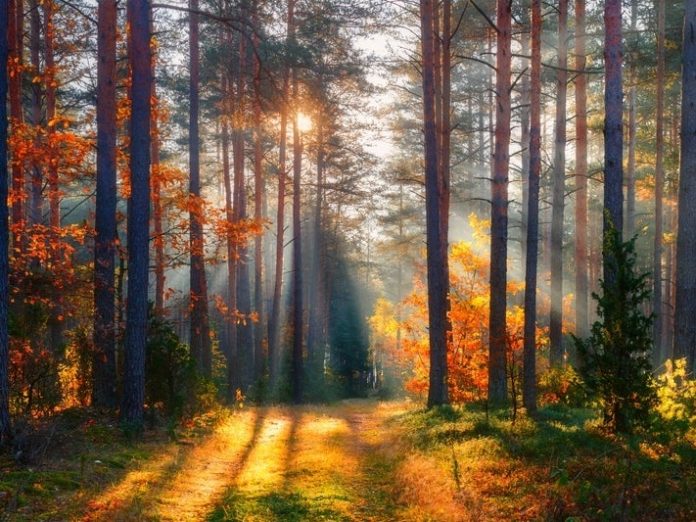GEORGIA — Rain in northern Georgia knocked leaves of blazing red, vibrant orange and sunny yellow off some trees, but other species are now turning to show their colors in the higher elevations.
The weekly 2020 Georgia Leaf Watch report for Oct. 16 said the Ridge and Valley/Cumberland Plateau in northwest Georgia said hickory, poplar, birch, and sassafras trees are beginning to shift from green to yellow and brown. Oaks are beginning to fade to brown with small hints of yellow. Dogwoods have surpassed peak as deep reds begin to dull, the Georgia Forestry Commission said.
In northeast Georgia, the remnants of Hurricane Delta took down some early-turning yellow poplar leaves. Color is becoming more noticeable at the upper elevations and along roadsides.
Foresters said that the state is just a few days behind where it was in 2014 and that year provided an excellent finale in terms of amount of color and intensity. “Crossing our fingers that the next two to three weeks will provide us with a similar conclusion,” the foliage report.
Above 3,000-feet elevation, oaks continue to transition to reds and yellows.
Roadsides continue to see significant increases in color with sourwood, maple, blackgum, dogwood, and sumac are adding reds to the roadside along with the yellow poplar and birches.
This week, hickories are beginning to show some initial golden yellows and every now and then a black walnut is bringing bright lemon yellow.
No predictive tool is 100 percent accurate, but using the newly released interactive “2020 Fall Foliage Prediction Map” can help you plan excursions to see autumn leaves at the peak of their splendor.
Developed as a tool to help vacationers book lodging and other accommodations in the Smoky Mountains, which rise above the Tennessee-North Carolina border, the Fall Foliage Prediction Map from SmokyMountains.com provides peak leaf change predictions for the entire continental United States.
To use the map, simply slide the scale to the right to see when leaves will peak in your state. Zero in on your county, and you’ll be able to decide whether it’s best to plan a northern, southern, eastern or western route.
In north Georgia, the weeks of Nov. 2 and 9 look good for a trip into the great outdoors, while the weeks of Nov. 16 and 23 are optimum leaf-color time for the rest of the state.
The Peach State offers some stunning vistas with hikes and trails to get into nature, including these state parks suggested by the Georgia State Parks website:
- Amicalola Falls State Park & Lodge — Dawsonville: Just an hour north of Atlanta you’ll find the Southeast’s tallest cascading waterfall.
- Black Rock Mountain State Park — Clayton: At an altitude of 3,640 feet, Black Rock Mountain is Georgia’s highest state park. Roadside overlooks and the summit Visitor Center offer sweeping views of the Blue Ridge Mountains.
- Cloudland Canyon State Park — Near Chattanooga: A favorite hike takes you down a staircase to the bottom of the canyon, where you’ll find two waterfalls.
- F.D. Roosevelt State Park — Pine Mountain: Many people are surprised to find hardwood forests and rolling mountains south of Atlanta. For a touch of history, drive to Dowdell’s Knob to see a life-size bronze sculpture of President Franklin Roosevelt and views of the forested valley.
- Fort Mountain State Park — Chatsworth: This park is best known for a mysterious rock wall along the mountain top, plus a variety of trails. For the easiest walk, take the 1.2-mile loop around the park’s green lake.
- Moccasin Creek State Park — Lake Burton: Georgia’s smallest state park sits on the shore of a deep-green lake. Guests can choose from the 2-mile Hemlock Falls Trail or 1-mile Non-Game Trail with a wildlife observation tower.
- Smithgall Woods State Park — Helen: Protecting more than 6,000 acres around Dukes Creek, this is the perfect spot for fly fishing while enjoying fall color. Day visitors can picnic near the creek, and overnight guests can hike a private trail to Dukes Creek Falls.
- Tallulah Gorge State Park — Near Clayton: Find one of the most spectacular canyons in the Southeast, and choose from easy or difficult trails. Hike along the rim to several overlooks with waterfall views, or get a permit from the park office to trek all the way to the bottom.
- Unicoi State Park & Lodge — Helen: New ziplines take you high above the forest canopy for a unique view of leaves.
- Vogel State Park — Blairsville: The 4-mile Bear Hair Gap Trail makes a nice day trip for experienced hikers, offering a birds-eye view of the park’s lake. For an easier walk, follow the Lake Loop to a small waterfall below the dam.
- George L. Smith State Park — Twin City: Join Mill Pond Kayak for a guided paddle trip under Spanish moss and tupelo trees. Photographers will appreciate exploring a covered bridge built in 1880.
- James H. Floyd State Park — Summerville: This quiet park in northwest Georgia has five miles of hiking trails, plus access to the 60-mile Pinhoti Trail.
- Victoria Bryant State Park — Royston: Located just minutes from I-85 in north Georgia, this little known gem has eight miles of hiking trails, a pretty stream and small fishing ponds.
What Causes The Different Colors
You probably remember from science class that the color change all starts with photosynthesis. Leaves constantly churn out chlorophyll — a key component in a plant’s ability to turn sunlight into the glucose it needs to thrive — from spring through early fall. Those cells saturate the leaves, making them appear green to the human eye.
Credit: Source link































